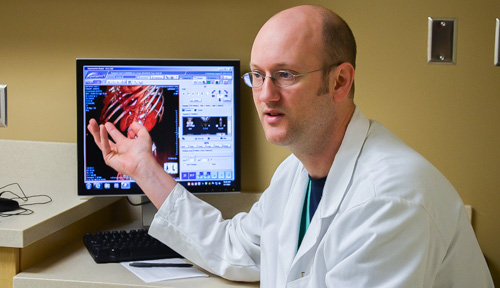Will investigate low-cost antibiotic to determine if it can inhibit enzymes that cause aneurysms
When diagnosed with an abdominal aortic aneurysm, all most people can do is worry, watch and wait. Timothy Baxter, M.D., professor of surgery at the University of Nebraska Medical Center, has compared it to being forced to live with the ticking of a time bomb.
It can take years before an aneurysm is recommended for repair – when it finally grows large enough (about 5.5 cm) that the risk of rupture outweighs the risk of surgery.
“This approach is very unsettling to patients,” Dr. Baxter said.
“Some people, every day they wake up worrying about it,” agreed UNMC’s Jason MacTaggart, M.D., “because even though most abdominal aortic aneurysms rupture at a size greater than about 5 and a half centimeters (2 inches), they can sometimes be unpredictable and cause problems even when small.”
Most would rather do something, anything. Now, at least a few of them can.
UNMC is the clinical coordinating center for a $12.2 million multi-center randomized placebo-controlled clinical trial of medical management of aortic aneurysm disease.
The management would be via a pill, which some scientists believe could significantly slow aneurysm growth. The study is being conducted under the auspices of a grant from the National Institutes of Health.
The Non-Invasive Treatment of Abdominal Aortic Aneurysm Clinical Trial (NTA3CT) aims to enroll 250 patients with the collaboration of 15 top academic medical centers across the U.S.
In addition to UNMC, the project’s pillar institutions include the University of Maryland Medical Center – for clinical trials management and design; University of Wisconsin School of Medicine and Public Health – for aortic imaging; and Washington University School of Medicine in St. Louis – for blood, lab and genetic testing.
Fifty percent of the trial’s enrollees will receive the antibiotic doxycycline, an inexpensive generic now widely used for acne and other conditions. Dr. Baxter’s preliminary research in animal models shows the drug inhibits the enzymes which weaken aortic walls, thus causing aneurysms.
If successful, it’s an inexpensive, noninvasive, proactive approach.
Dr. MacTaggart, a vascular surgeon, said the surgery to repair aneurysms can come with a mortality rate of up to 3 percent – and a cost of about $20,000. More than 40,000 such procedures are done each year nationwide.
“Multiply all of that together,” Dr. MacTaggart said. “If you can change a $100,000 operation to $10 a year for some pills, it’s going to save the health care system a ton of money.”
But, the study will show more than whether or not the pill works. It should also garner a host of invaluable information.
And its enrollees will be doing something about the disease, rather than just biding time.
Aortic aneurysms affect 3 percent to 5 percent of the population, but are most common in men age 65 and older, often smokers with a family history.
"It's considered a silent killer," Dr. Baxter said, "because there are no symptoms until it ruptures. Most aneurysms we find by luck when imaging is done for other medical conditions."
And then, there is only worrying and waiting as it grows. Nothing you can do.
Until now.
Academic health science centers enrolling patients in the clinical trial:
Baptist Health Medical Center, Miami, Fla.
Beth Israel Deaconess Medical Center (Harvard University), Boston
Cleveland Clinic Lerner College of Medicine, Cleveland, Ohio
Geisinger Medical Center, Danville, Penn.
Columbia University Medical Center, New York
Northwestern University, Chicago
Oregon Health and Science University, Portland
University of Arizona Health Sciences Center, Tucson, Ariz.
University of Cincinnati College of Medicine, Cincinnati, Ohio
University of Maryland School of Medicine, Baltimore
University of Michigan, Ann Arbor, Mich.
University of Nebraska Medical Center, Omaha, Neb.
University of Utah Health Sciences Center, Salt Lake City
University of South Florida Health South, Tampa, Fla.
Washington University School of Medicine, St. Louis, Mo.
National principal investigators:
Clinical Coordinating Center Director
Timothy Baxter, M.D.
Professor, department of surgery
University of Nebraska Medical Center
Data Coordinating Center Director
Michael Terrin, M.D., M.P.H.
Professor, department of epidemiology and public health
University of Maryland School of Medicine
Imaging Core Laboratory Director
Jon Matsumura, M.D.
Professor and chairman, division of vascular surgery
Medical director, AortaCore Imaging Lab
University of Wisconsin School of Medicine and Public Health
Biomarkers Core Lab Director
John Curci, M.D.
Associate professor, department of surgery
Washington University in St. Louis
